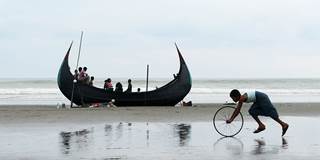By 2030, most of the world’s poor will live in regions suffering from some form of "fragility," forcing millions to flee their homes. Donors can prepare now by allocating money to address the causes of displacement, rather than focusing disproportionately on the effects.
PARIS – With newspapers full of stories about the challenges migrant families face, it might be tempting to assume that the causes of displacement are also being addressed. In most cases, however, such an assumption would be wrong. Today, solutions to forced migration focus almost exclusively on aiding refugees after they flee, rather than targeting the reasons for their flight. To resolve the world’s refugee crises, the causes require as much attention as the effects.
Why would parents risk their lives, or the lives of their children, to leave home and journey into the unknown? And what can be done to keep families from being forced to migrate in the first place? These are among the key questions that colleagues and I have attempted to answer in a new OECD study, States of Fragility 2018. The findings are as illuminating as they are troubling.
By 2030, more than 80% of the world’s poor will live in an area defined as “fragile” – a status that may reflect any number of political, social, security, economic, or environmental causes. Unfortunately, if current trends hold, far too little development aid will be allocated to address the factors contributing to fragility. In 2016, for example, just 2% of the $68.2 billion in official development assistance (ODA) that went to places affected by fragility was used for conflict-prevention activities, and only 10% went to peace-building initiatives. There is no other conclusion to draw: we must change how ODA is allocated.

PARIS – With newspapers full of stories about the challenges migrant families face, it might be tempting to assume that the causes of displacement are also being addressed. In most cases, however, such an assumption would be wrong. Today, solutions to forced migration focus almost exclusively on aiding refugees after they flee, rather than targeting the reasons for their flight. To resolve the world’s refugee crises, the causes require as much attention as the effects.
Why would parents risk their lives, or the lives of their children, to leave home and journey into the unknown? And what can be done to keep families from being forced to migrate in the first place? These are among the key questions that colleagues and I have attempted to answer in a new OECD study, States of Fragility 2018. The findings are as illuminating as they are troubling.
By 2030, more than 80% of the world’s poor will live in an area defined as “fragile” – a status that may reflect any number of political, social, security, economic, or environmental causes. Unfortunately, if current trends hold, far too little development aid will be allocated to address the factors contributing to fragility. In 2016, for example, just 2% of the $68.2 billion in official development assistance (ODA) that went to places affected by fragility was used for conflict-prevention activities, and only 10% went to peace-building initiatives. There is no other conclusion to draw: we must change how ODA is allocated.